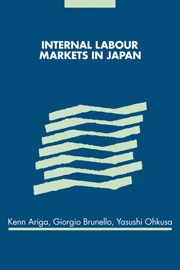Book contents
- Frontmatter
- Contents
- List of figures
- List of tables
- Preface
- Introduction
- Part I Features of Japan's internal labor markets
- 1 Internal labor markets in search equilibrium
- 2 Demand and supply of skills in a corporate hierarchy
- 3 Measuring occupational and internal labor markets
- 4 Earnings and seniority in internal labor markets
- 5 Recruitment and promotion in Japanese firms
- 6 Product market competition and internal labor markets
- Part II Recent changes in wage and employment structures
- Epilog
- References
- Index
6 - Product market competition and internal labor markets
Published online by Cambridge University Press: 22 September 2009
- Frontmatter
- Contents
- List of figures
- List of tables
- Preface
- Introduction
- Part I Features of Japan's internal labor markets
- 1 Internal labor markets in search equilibrium
- 2 Demand and supply of skills in a corporate hierarchy
- 3 Measuring occupational and internal labor markets
- 4 Earnings and seniority in internal labor markets
- 5 Recruitment and promotion in Japanese firms
- 6 Product market competition and internal labor markets
- Part II Recent changes in wage and employment structures
- Epilog
- References
- Index
Summary
Overview
In this chapter we study the interactions between competition within the firm and competition among firms in the labor market. Our main objectives are: (1) to evaluate the degree of insulation of internal labor markets from competition in the external labor market; (2) to measure the interactions between internal labor market (ILM) arrangements and product market competition.
Perhaps the clearest picture that we can draw on these issues follows the logical implications of the iron law of competition. According to this law, a firm cannot enforce any arrangement that can be over-ruled by competition. Most of the arrangements discussed in this book so far cannot be implemented unless firms and employees are to some extent insulated from the discipline of the external labor market.
Take, for example, the late selection approach investigated in chapter 5. Unless the firm has an information advantage with respect to other firms over the quality of its employees, or there are frictions preventing employees from freely seeking their best employers, such a policy is clearly untenable. Given the fact that the large majority of white-collar workers in large Japanese firms tends to stay with one firm for an extended period of time, there is little doubt that firms do have at least some room to choose and design their employment and wage policy in order to meet specific needs and conditions. An important question to ask is thus to what extent these firms are insulated from the external labor market.
- Type
- Chapter
- Information
- Internal Labour Markets in Japan , pp. 169 - 186Publisher: Cambridge University PressPrint publication year: 2000



